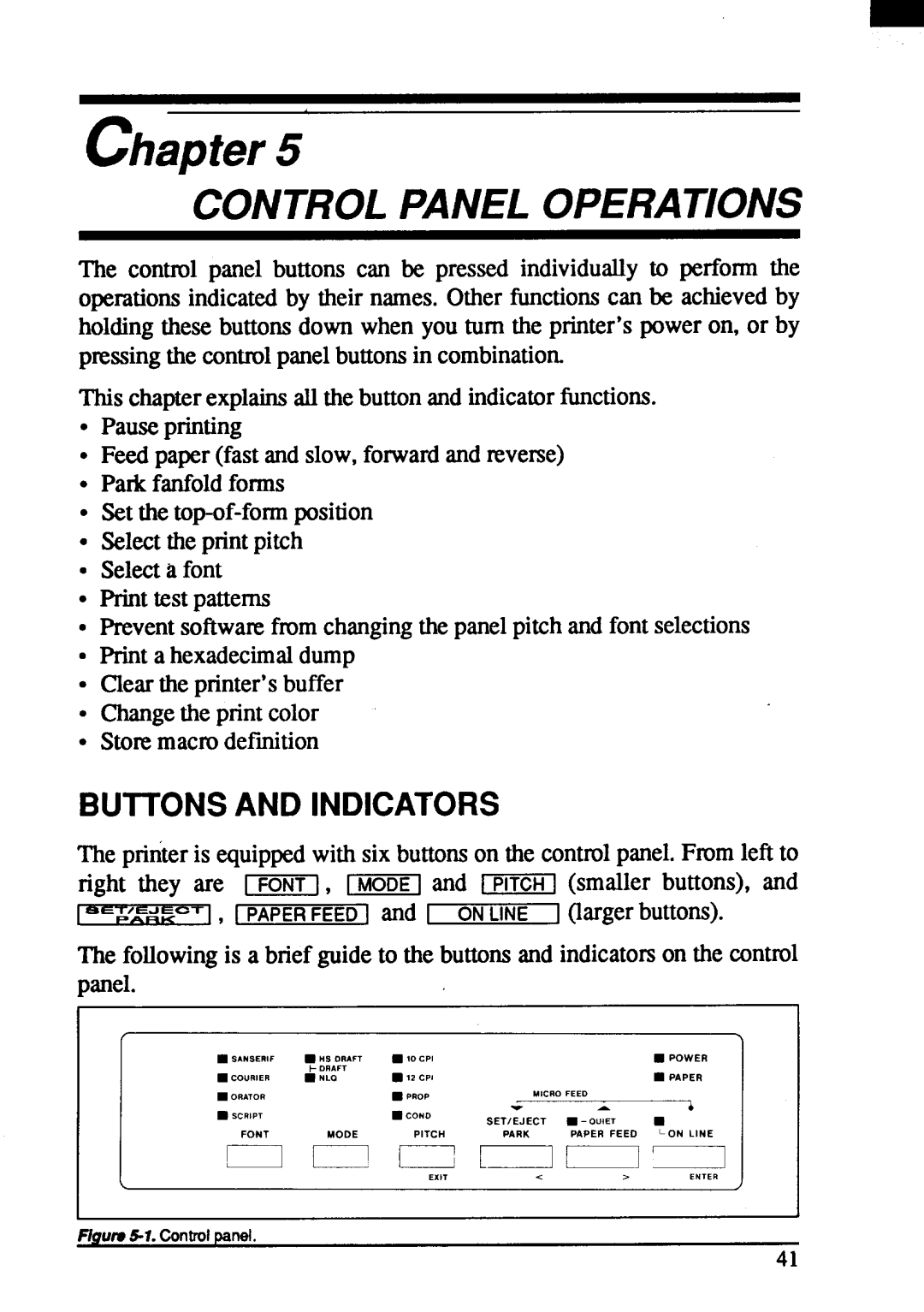ZA-200MULTI-FONT ZA-250MULTI-FONT
ZA-200 ZA-250
VDE Statement
Howto Usethis Manual
Reference
Table of Contents
Settingthememoryswitches
112
Fontcontrolcommands
103
117
Intematkd Cbaractasets
137 141 142 143 144 146 147 154 155 157 161
Featuresof the Printer
Chapter
Printercomponents
Page
Fontstyle Example
Sewing UP Theprinter
Locatingthe Printer
Unpackingand Inspection
Page
SEIllNG UP
Mountingthep~atenknob
Install the ribboncartridge
Connectingthe interfacecable
@wu24 MOW tha dips untilyou haar adick
Page
Automaticsheet Feeder
Single-BinAutomaticSheetFeeder SF-10DMII/15DMII
Openrhefrontcover,andswingdmvrtthetransparentpart
Aufomatic Sheet Feeder
~owtifmnt cxwerwiththe tmsparent part in the openposition
Figurv SRObw he mtcowr
GLuw3z In8eflthe Stackeratmdments
Dual-BinAutomaticSheetFeeder SF-IORMIII15RMII
@-=A- fhedeaf @8tiCpU@fS~ ts lheAIJIDMaUCmeetFeeder
Pulltractorunit PT-10XM/15XM
~ww3.11. Mountthe PullTractorUnit ontothe printer
Interfacecartridges
12.Remove@wStandardInterfaoeCarkidge fromthe printer
DIP SwitchFunctionson TheSerial Interface Cartridge
OFP OFF OFP 150BPS
Page
Paperinstallationand USE
Selectionof Paper
Adjustingthe Printinggap
Loadingfanfoldforms
Loadingthepaper from the rear of theprinter Pushfeed
Tractor cover
Loadingthepaper from the bottomof theprinter
Loadingthepaper with Push/Pullfeed
Flgurv4-8.Mountthe fanfoldpaperover the internaltractorunits
Clamp lever
Paperparking
Paper unparklng
Loadingthepaper withoutoptionalaccessories
Loadingsinglesheets
13.Loadinga singlaahaet
Loadingthepaper with optionalAutomaticSheet Feeder
Gwv4-16. Adjuetthepeperguidesto~thewidthofmepepef
FlguIw~77. FanW paperbeforeinswdngIntotheASF
Buttonsand Indicators
Controlpaneloperations
Online Wtton
Paperfeed button
SETIEJECT/PARKbutton
PITCHbutton
HS-Draft
MODEbutton
Font button
NearLetterQuality
POWER-UPFUNCTIONS
Short test mode
Long test mode
Font lock mode
Print area test mode
Pitch lock mode
Pitch and Font lock mode
Hexadecimaldump
Cading for IBM-PCwith coloradapter
Topof form
Switchcombinationfunctions
Form feed
Changingthe auto loading value
Forwardmicro-feed
Reversemicro-feed
Button Whileholdingthe
Clearingthe buffer/Allreset
Selectingtheprint color
Blue
SelectingtheASF bin number
Red
Violet
StoreMacro Definition
Chapter
Main Menu
Print currentsettings
Menuoptions
Hwtallationmenu
Communalmenu
Font menu
Print menu
Papermenu
Factorysettings
Dotadjustmentmode
HS-DWFT +
Mode
Indicatesthe ASCIIcodingof thecommand.Con
Std
Nized Std Standardmode
Select draft elite characters
Select draft qualitycharacters
Select draftpica characters
Select NLQ characters
Seleutitalic characters
SelectNLQ font
Select font
Causessubsequentcharactemto be printedin italics
Select uprightcharacters
Cancelemphasizedprinting
SelectNLQ italic characters
Emphasizedprinting
Stop underlining
Canceldouble-strikeprinting
Start underlining
Start overlining
Subscript
Cancelsuperscriptor subscript
Superscript
Select characterset #1
Select standardcharacterset
Select IBM characterset
Select characterset #2
Selectinternationalcharacterset
Select IBM codepage
Select slashzero
Enableprinting of all charactercodes
Enable printing of all character codes on next character
Select normalzero
Elitepitch
Cancelcondensedprinting
Picapitch
Condensedprinting
Caneelexpandedprinting
Cancelone-lineexpandedprinting
Expandedprinting
Selectpropotfionalspacing
Increase characterspacing
Select masterprint mode
Fixed spacing
Print double-heightcharacters
Select doubleor quadruplesize
Select charactersize
Returnto normalheight
Select characterheight, width,and line spacing
Set line spacingto 7~2 inch
Verticalpositioncommands
Set line spacingto 1/8 inch
Set line spacingto 1/6inch
Line feed
Set line spacingto n/72 inch
ExecuteESC a
Reverseline feed
Feedpaper n lines
Performone n/216-inchline feed
Performone n/216-inchreverseline feed
Set top of page at currentposition
Setpage length ton lines
Cancelbottommargin
Cancelsthe bottommargin
Set page length ton inches
Returnto top of currentpage
Disablepaper-outdetector
Enablepaper-outdetector
Set verticaltab stops
Select verticaltab channel
Set verticaltab stopsevery n lines
Set verticaltab stops in channel
Verticaltab
Cesg l
L m
CESC 27 S0 nl 5S nl
T l m
N t s
Oa 6 t p h m + n D a
N p
W f n F w
H a + x 2 d w M M s A t l + x 2 D
W f F w
43SC
27 94d
6 a t w D a t l
M m
6 s
Font
IB 26
27 73 IB 49
Red Blue
Ascii
27 S5 4S IIB 55 I27 S5 O
27 25
B # a f
Download Characters
T d M c C s
Da d
M n h
L s A t l p A b
S t l
Lprint Lprint CHEMICALS’’ CHR$9
Next Lprint
D h D a p
T d D w l
BlIDTH LPT1 ,255
Exports
W w I a D n D w l
M d T d w t
F p d w
I I I I I
64, 70
CHE G
116
MS-DOS and Your Printer
F t y p M c
Memory
T c
A p F n ? E
A e
U t m D
T D
M a b Wo s A s
With Basic
Codes 1010
124
1660
125
128
How theprogram works
Print
Resident Fonts Are
Courier Characters
Condensedpica pitch 17CFII
Memo
Troubleshooting and Maintenance
Troubleshooting
Printing
Powersupply
If the POWERindicatordoes not illuminate,checkthe following
If the printoutis not whatis expected
If the printis faint,or uneve~ checkthe following
If dots are missingin the printing,checkthe following
131
Paper feeding
Is thepapertoothick or too thin?
134
Maintenance ‘
Replacingthe Printhead
136
Replacingtheprinthead
Specifications
Frictionor push tractorfeed standard
Normaltype Widetype
Pica 18X23 Elite 9x8 Bit imagedot-matxix
Bottomfeed or Push/PuUfeed option
WithoutDownload 32 kB With Download 14kB
Original+2 copiesMulti-partmodeoff
Original+4 copiesMulti-partmodeon
StandardmodeEpsonEX-800/1000
Power supply Optio~
Highwhenactive
Pinoutof Interfaceconnector
Parallel intetiace
Whwhenactive
Receivedata
Serial h7terface
IN-R 21-25 N/C
Charactersets
1C4
Standardcharacterset #2
171
145
Internationalcharactersets
IBM characterset #2
148
JL-1
Othercharactersare identicalto CodePage #437
CodePage #860 Portuguese
CodePage #861 Icelandic
Othercharactersare identicalto CodePage #437 152
Othercharactersare identicalto CodePage #437 153
DC322
Characterset #1
Additionalcharactemcan be printedby specialcommands 155
IBM special characterset
156
BeU,100 Bidirectionalpriming,100
AUrestx Applicationsoflware,117 Ascen
Attributeda@104
ItalicChfUilCttTS,67
MS-DOS,117
IJ!J
Followingcommandstake effectwith the Standardmode
StandardMode
162
163
Followingcommandstake effectwith the IBM mode
IBMtl&lode
?$ts$%edla.am%des72
Star MicronicsTechnicalHotline

